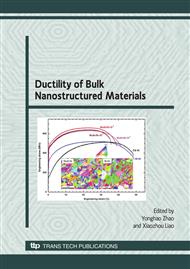[1]
J. R. Weertman, D. Farkas, K. Hemker, H. Kung, M. Mayo, R. Mitra, and H. Van Swygenhoven, MRS Bull. 24, 44 (1999).
DOI: 10.1557/s088376940005154x
Google Scholar
[2]
Y. T. Zhu and X. Z. Liao, Nature Mater. 3, 351 (2004).
Google Scholar
[3]
K.S. Kumar, H. Van Swygenhoven, S. Suresh, Acta Mater. 51, 5743 (2003).
Google Scholar
[4]
K. S. Kumar, S. Suresh, M. F. Chisholm, J. A. Horton, and P. Wang, Acta Mater. 51, 387 (2003).
Google Scholar
[5]
T. F. Dalla, H. Van Swygenhoven, M. Victoria. Acta Mater. 50, 3957 (2002).
Google Scholar
[6]
H. Q. Li and F. Ebrahimi, Appl. Phys. Lett. 84, 4307 (2004).
Google Scholar
[7]
H. Q. Li and F. Ebrahimi, Acta Mater. 54, 2877 (2006).
Google Scholar
[8]
A. Rinaldi, P. Peralta, C. Friesen, K. Sieradzki, Acta Mater. 56, 511(2008).
Google Scholar
[9]
K. M. Youssef, R. O. Scattergood, K. L. Murty, J. A. Horton, and C. C. Koch, Appl. Phys. Lett. 87, 091904 (2005).
DOI: 10.1063/1.2034122
Google Scholar
[10]
Cheng S, Ma E, Wang YM, Acta Mater. 53, 1521 (2005).
Google Scholar
[11]
Z. Shan, E. A. Stach, J. M. K. Wiezorek, J. A. Knapp, D. M. Follstaedt, and S. X. Mao, Science 305, 654 (2004).
Google Scholar
[12]
R. L. Coble, J. Appl. Phys. 34, 1679 (1963).
Google Scholar
[13]
J. Schiøtz and K. W. Jacobsen, Science 301, 1357 (2003).
Google Scholar
[14]
V. Yamakov, D. Wolf, S. R. Phillpot, A. K. Mukherjee, and H. Gleiter, Nat. Mater. 1, 1 (2002).
Google Scholar
[15]
V. Yamakov, D. Wolf, S. R. Phillpot, A. K. Mukherjee, and H. Gleiter, Nat. Mater. 3, 43 (2004).
Google Scholar
[16]
H. Van Swygenhoven and P. M. Derlet, Phys. Rev. B 64, 224105 (2001).
Google Scholar
[17]
R. E. Rudd and J. F. Belak, Comput. Mater. Sci. 24, 148 (2002).
Google Scholar
[18]
Y. Mishin, M.J. Mehl, D.A. Papaconstantopoulos, A.F. Voter, J.D. Kress. Phys. Rev. B 63, 224106 (2001).
Google Scholar
[19]
Y. Mishin, D. Farkas, M. J. Mehl, and D. A. Papaconstantopoulos, Phys. Rev. B 59, 3393 (1999).
Google Scholar
[20]
G. Z. Voronoi, J. Reine Angew. Math. 134, 199 (1908).
Google Scholar
[21]
A. Cao, Y. Wei, Phys. Rev. B 76, 024113 (2007).
Google Scholar
[22]
A.J. Cao, Y.G. Wei, and E. Ma, Phys. Rev. B 77, 195429 (2008).
Google Scholar
[23]
A. G. Frøseth, H. Van Swygenhoven, and P. M. Derlet, Acta Mater. 52, 2259 (2004).
Google Scholar
[24]
Y. J. Wei and L. Anand, J Mech. Phys. Solids 52, 2587 (2004).
Google Scholar
[25]
V. Yamakov, E. Saether, D. R. Phillips, and E. H. Glaessgen, J Mech. Phys. Solids 54, 1899 (2006).
Google Scholar
[26]
F. Ebrahimi, G.R. Bourne, M.S. Kelly, T.E. Matthews, Nanostructured Mater. 11, 343 (1999).
Google Scholar


